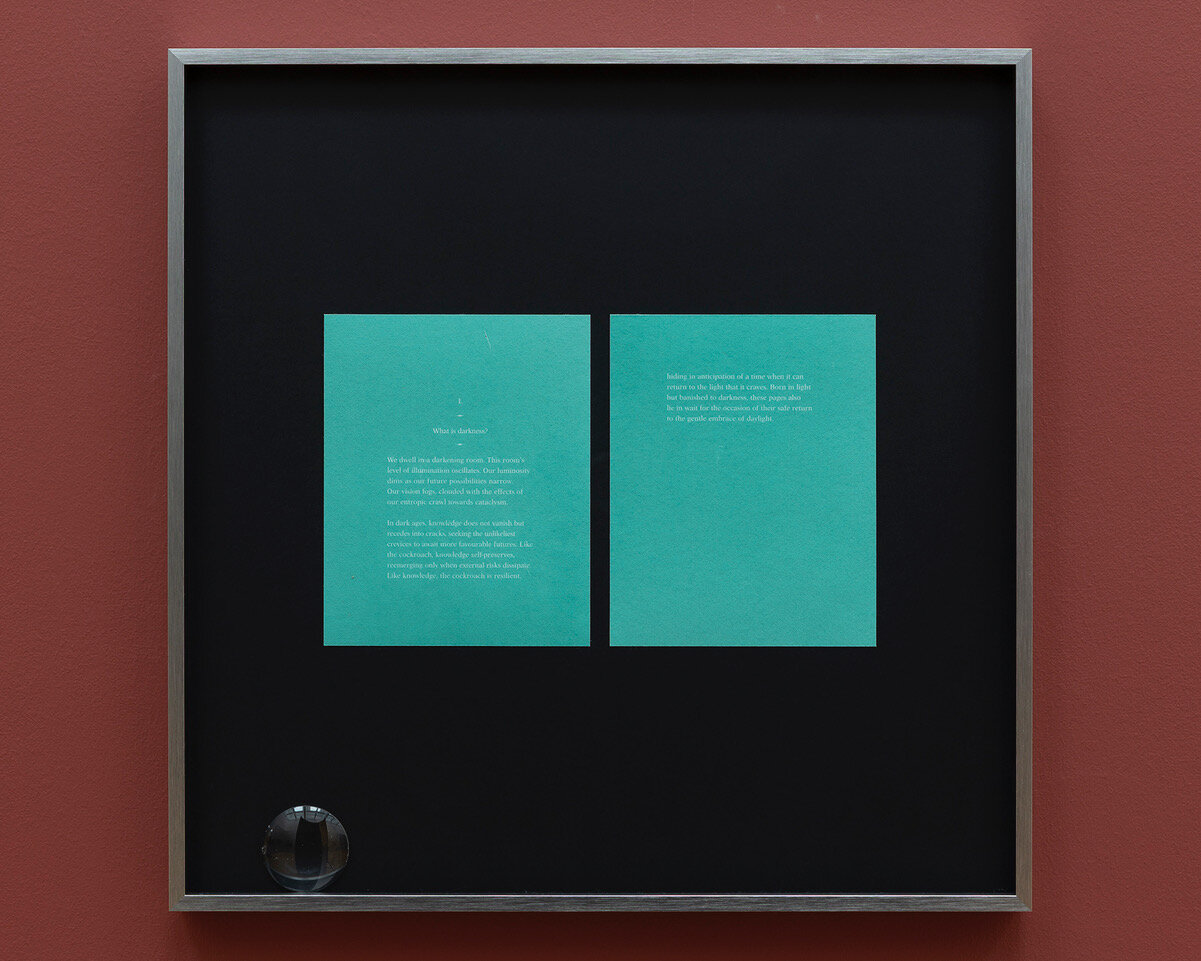Studio for Propositional Cinema

Manual: The Camera of Disaster (I. What is darkness?), 2022
Aluminium frame with a glass lens and two gum dichromate prints made with cotton paper, gum arabic, potassium dichromate and pigments produced from oxidised copper scraps and a rubber tire from an automobile explosion
51,2 x 51,2 cm
Edition of 3 + 1 AP (#3/3)
Courtesy the artist; Tanya Leighton, Berlin/Los Angeles
Photo: Noah Friebel
The collective Studio for Propositional Cinema works in different media and forms. In photographs, texts, installations, settings, and performances, Studio for Propositional Cinema develops very diverse groups of works that might address the history of collective work, or might also further develop various formats in the cultural context, or test out their limits. The work shown in this exhibition, by contrast, is rather an exploration of the artistic medium itself — photography.
Manual: The Camera of Disaster is a work that fantasizes about the rediscovery or reinvention of photography, and, as the title suggest, provides instructions for this, as the first text plate directly explains: “Notice to the Reader: The images, texts, and objects here, are intended to help facilitate the creation of photographic images in such a future these processes have been lost or eradicated.”
The starting point is the premise that humankind has been thrown back in its development by a catastrophe and has lost much practical knowledge, including a knowledge of photography. Inspired by the pioneering historical text The Pencil of Nature by William Henry Fox Talbot, the first frames provide a very practical set of photochemical instructions, such as how to use lenses, paper, and chemicals, but then they culminate in questions concerning the medium itself. “What is an image?” and “What is a photography?” are questions that can be answered in the individual frames of this work, which can also be understood as chapters. The text is written by the collective, set into 26 picture frames and provided with a small number of objects. For each theme of the chapter in question, objects are also inserted into the frames. The frame entitled “What is darkness?” contains a lens, for example, and the next three frames include chemicals for the development of photographic images. From frame number 7 (“What are lenses?”) the texts are all combined with a picture. In frame 8 (“What is a camera?”), for example, we see the box that has been made into a camera that is also on display in the exhibition space. Beyond the level of the technical process to produce a photograph, the discussion also looks at the social value that pictures may have, how they may have positive effects, or what influence they may have in general. This debate is not just relevant for an imaginary society that has to relearn how to use the medium, of course, and it also falls on fertile ground in our own social context.
The final text segment addresses how we might imagine the future of pictures: “The manual is a script. Scripts are blueprints for propositional action. They are open structures made to be rewritten and improvised, given new meaning. When we hold our cameras with intention, we become directors of the world around us. Our cameras enliven with their potential.“
Within its dramatic setting of a possible loss, the story told by this work nonetheless ends very positively, with an attempt to emphasize the pictorial and narrative potential of image-based media, and to reinforce both the real and fictitious beholders in a belief in the power of pictures that they can use for themselves.
The Camera of Disaster, 2022
Texts in 26 aluminum frames, mixed media
each 51,2 x 51,2 cm
Edition of 3 + 1 AP (#3/3)
Courtesy the artists; Tanya Leighton, Berlin/Los Angeles
Studio For Propositional Cinema
Solo (et al.): Museum Abteiberg, Mönchengladbach (2022), Tanya Leighton, Berlin (2022, 2015, 2014), Galerie Max Mayer, Düsseldorf (2022), Fondazione Morra Greco, Naples (2019), Kunsthalle Sankt Gallen (2018), Kestner Gesellschaft, Hannover (2017), Swiss Institute, New York (2017), Taylor Macklin, Zurich (2017), Bonner Kunstverein (2016), Kunsthaus Bregenz (2016), mumok – Museum moderner Kunst Stiftung Ludwig Wien, Vienna (2015); Shows (et al.): Galeria Wschód, Warschau (2022), km Kunstverein Munich (2021), Material, Zurich (2021), Layr, Vienna (2021), ML Fine Art, Milan (2020), Akademie-Galerie, Kunstakademie Düsseldorf (2019), Projektsrom Normanns, Stavanger (2019), Bielefelder Kunstverein (2018), Museum Morsbroich, Leverkusen (2015), Leeschenhof, Quadriennale, Düsseldorf (2014)